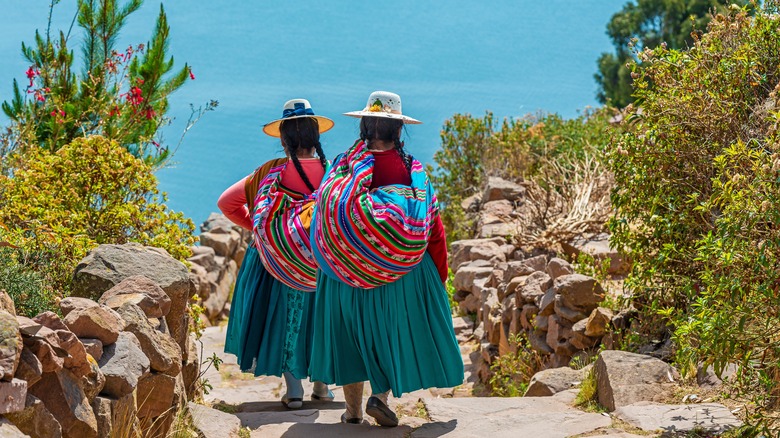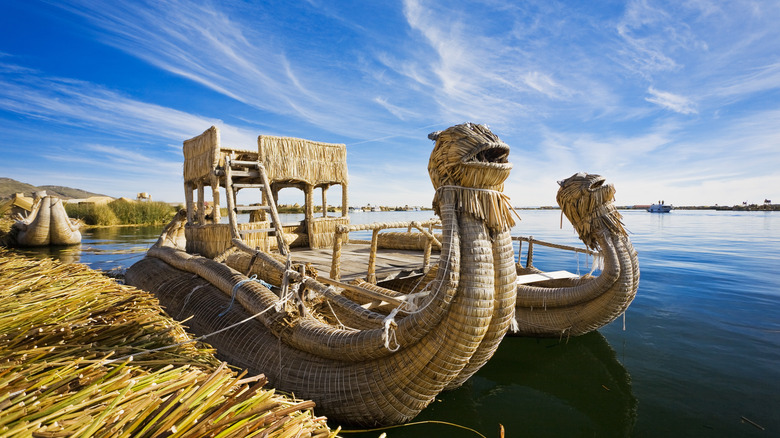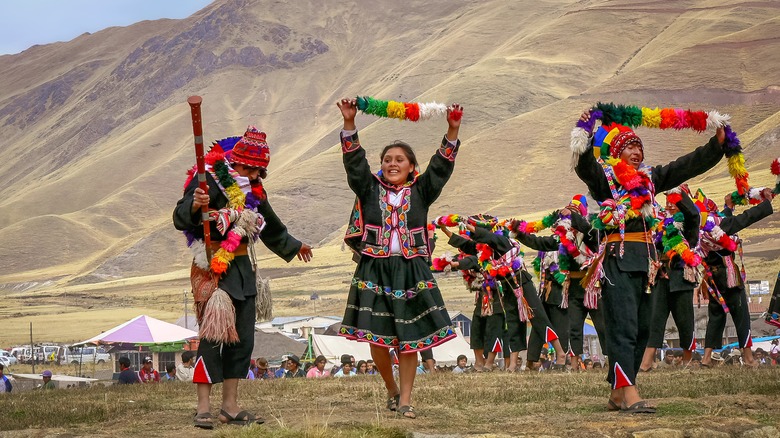Visit One Of The Largest Lakes In South America At This Underrated Destination
South America has some fascinating places to visit. You can check out the beautiful Copacabana Beach in Brazil, wander the bustling streets of Buenos Aires in Argentina, or even spot wildlife on the Galapagos Islands in Ecuador. However, there is a beautiful lake on the border between Peru and Bolivia that has sights you just cannot get anywhere else — Lake Titicaca. (We've heard all the jokes, so go ahead and get them out of your system.) This is the highest navigable body of water in the world, sitting at 12,549 feet above sea level, and the largest freshwater lake in South America. And the best part? You can access it easily from the charming lakeside city of Puno, Peru.
The area has some interesting historical sites to visit, from the 18th-century cathedral in the town square, the Sillustani Cemetery of the ancient Qulla people, the White Giant of Huajsapata, and the unusual floating islands on the lake where a small community of people still live. In fact, you can even stay with a family on some of them. How many places can say that? Let's take a look at the intriguing and unique experiences you can have in this South American gem.
What to know about Lake Titicaca before you visit
The area is perfect for wildlife lovers. It is a haven for aquatic creatures, like the Titicaca water frog and 24 species of freshwater snails. Avid bird watchers can also spot white-tufted grebes, Puna ibis, Chilean flamingos, Andean coots, and snowy egrets.
The big draw, however, is the Uros floating islands. There are human-created islands made from local reeds woven together called totora. People have lived on them since around 1400 B.C.E., before the time of the Incas, and it's believed that they were made to avoid invaders. You can take a boat tour, but you can also book an overnight stay with one of the local Uros families. They'll tell you all about how they replenish and change the reeds every six months, and how they create their homes, furniture, and boats from the same material.
One thing to keep in mind about the area is that because it's at such a high elevation, you should get plenty of sleep, avoid drinking a lot of alcohol, and make sure you drink water and eat more than usual. You absolutely must wear sunscreen as well, because you can burn quicker than at lower elevations. Weather-wise, this is pretty much perfect. The average daytime temperature is around 60-65 Fahrenheit for most of the year, though it does drop quite a bit at night. The dry season, from April through November, is the best time to visit, but if you're traveling to Peru on a small budget or in the off-season, you can still enjoy the lake year-round.
Things to see in the nearby city of Puno
Puno itself has a lot to do outside of Lake Titicaca. You can stroll along the Jiron Lima, with its eateries, markets, and stores. Visit nearby Parque Pino to see the monument to Dr. Manuel Pino, the 19th-century soldier who died in the War of the Pacific, and to get a great view of the Church of San Juan Bautista. Sunday afternoon is a great time to check out the local street vendors in the area if your stay keeps you there over the weekend.
The Puno local dance and dress are stunning, and you can see it all on display during the colorful Festival of the Virgin of La Candelaria, which takes place for two weeks in February. Check out the Sillustani Cemetery near Puno, which features the funerary towers, or chullpas, of the Qulla people, who were conquered by the Incas in the 15th century. Don't miss the Tower of the White Giant of Huajsapata, which is a statue of Manco Capac, who is the Incan guardian of the city of Puno, and son of Viracocha, the creator god.
Visit the main square, the Plaza de Armas, to see the 1757 cathedral designed by Simón de Astro. Right across from there is La Casa del Corregidor, a lovely bright yellow and blue house built in 1668, which is now a shop, cafe, and library. It serves tapas and beer in the evenings and often hosts local art exhibitions.


